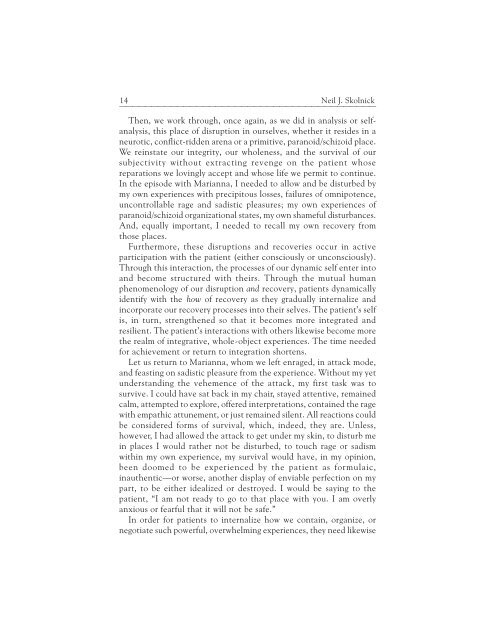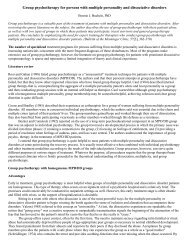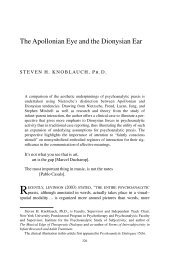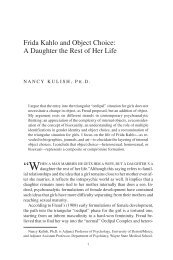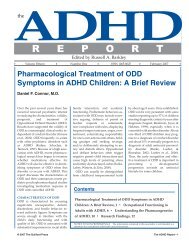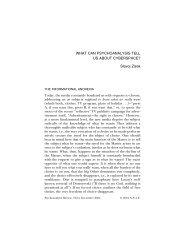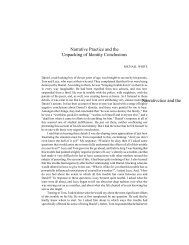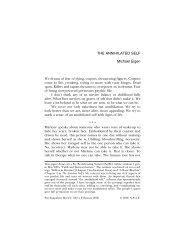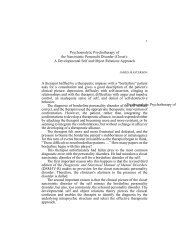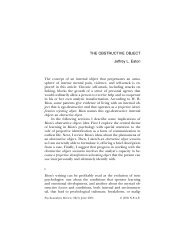What's a Good Object to Do? - PsyBC
What's a Good Object to Do? - PsyBC
What's a Good Object to Do? - PsyBC
Create successful ePaper yourself
Turn your PDF publications into a flip-book with our unique Google optimized e-Paper software.
14 Neil J. Skolnick<br />
⎯⎯⎯⎯⎯⎯⎯⎯⎯⎯⎯⎯⎯⎯⎯⎯⎯⎯⎯⎯⎯⎯⎯⎯⎯⎯⎯⎯⎯⎯⎯⎯⎯⎯⎯⎯⎯⎯⎯⎯<br />
Then, we work through, once again, as we did in analysis or selfanalysis,<br />
this place of disruption in ourselves, whether it resides in a<br />
neurotic, conflict-ridden arena or a primitive, paranoid/schizoid place.<br />
We reinstate our integrity, our wholeness, and the survival of our<br />
subjectivity without extracting revenge on the patient whose<br />
reparations we lovingly accept and whose life we permit <strong>to</strong> continue.<br />
In the episode with Marianna, I needed <strong>to</strong> allow and be disturbed by<br />
my own experiences with precipi<strong>to</strong>us losses, failures of omnipotence,<br />
uncontrollable rage and sadistic pleasures; my own experiences of<br />
paranoid/schizoid organizational states, my own shameful disturbances.<br />
And, equally important, I needed <strong>to</strong> recall my own recovery from<br />
those places.<br />
Furthermore, these disruptions and recoveries occur in active<br />
participation with the patient (either consciously or unconsciously).<br />
Through this interaction, the processes of our dynamic self enter in<strong>to</strong><br />
and become structured with theirs. Through the mutual human<br />
phenomenology of our disruption and recovery, patients dynamically<br />
identify with the how of recovery as they gradually internalize and<br />
incorporate our recovery processes in<strong>to</strong> their selves. The patient’s self<br />
is, in turn, strengthened so that it becomes more integrated and<br />
resilient. The patient’s interactions with others likewise become more<br />
the realm of integrative, whole-object experiences. The time needed<br />
for achievement or return <strong>to</strong> integration shortens.<br />
Let us return <strong>to</strong> Marianna, whom we left enraged, in attack mode,<br />
and feasting on sadistic pleasure from the experience. Without my yet<br />
understanding the vehemence of the attack, my first task was <strong>to</strong><br />
survive. I could have sat back in my chair, stayed attentive, remained<br />
calm, attempted <strong>to</strong> explore, offered interpretations, contained the rage<br />
with empathic attunement, or just remained silent. All reactions could<br />
be considered forms of survival, which, indeed, they are. Unless,<br />
however, I had allowed the attack <strong>to</strong> get under my skin, <strong>to</strong> disturb me<br />
in places I would rather not be disturbed, <strong>to</strong> <strong>to</strong>uch rage or sadism<br />
within my own experience, my survival would have, in my opinion,<br />
been doomed <strong>to</strong> be experienced by the patient as formulaic,<br />
inauthentic—or worse, another display of enviable perfection on my<br />
part, <strong>to</strong> be either idealized or destroyed. I would be saying <strong>to</strong> the<br />
patient, “I am not ready <strong>to</strong> go <strong>to</strong> that place with you. I am overly<br />
anxious or fearful that it will not be safe.”<br />
In order for patients <strong>to</strong> internalize how we contain, organize, or<br />
negotiate such powerful, overwhelming experiences, they need likewise


